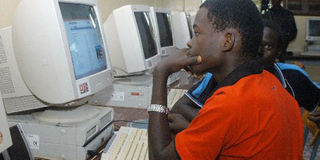Why rural ICT investment is key to our economy

Residents of Sega browse the net after the launch of Sega Silicon Valley Community ICT centre in rural Kenya.
What if Kenya’s next tech visionary — a coder, entrepreneur, or innovator — is a student in a rural classroom, staring at a blackboard with no computer in sight?
This question captures how critical the challenge of ensuring equitable access to information and communication technology (ICT) in rural schools has become. It is not just about hardware — it’s about unlocking opportunity, fostering empowerment, and ensuring no Kenyan is left behind in the nation’s digital transformation.
Kenya’s ambition to become a digital-first economy, as outlined in Vision 2030 and the Kenya National Digital Master Plan 2022–2032, is bold and well underway.
The government’s Digital Superhighway Project, launched in 2023, aims to lay 100,000 kilometers of fiber optic cable, create 25,000 public Wi-Fi hotspots, and establish Digital Village Smart Hubs in each of the country’s 1,450 wards. These hubs are designed to serve as centres for innovation, cybersecurity training, and digital services, transforming rural areas into engines of economic growth.
Yet, the true potential of this vision hinges on bringing digital tools to the heart of rural communities — starting with schools. Rural schools are often the most established institutions in any community. When equipped with electricity connectivity, computers, reliable internet, and smart learning tools, they become more than places of learning. Early exposure to digital tools fosters critical thinking, creativity, and problem-solving, skills essential for thriving in a modern workforce.
For instance, the Digital Literacy Programme (DLP), or DigiSchool, has already reached over 24,000 public primary schools, introducing young learners to digital technology. By expanding such initiatives, Kenya can ensure that rural students are not just consumers of technology but creators of it.
ICT also transforms the teaching experience. Educators gain access to global resources, online training, and collaborative platforms, enabling them to deliver dynamic lessons. Beyond academics, investing in rural ICT promotes social equity.
The digital divide in Kenya is stark: while 67 per cent of urban youth possess basic ICT skills, the figure is significantly lower in rural areas, where only 17 per cent of the population has internet access compared to 44 per cent in urban centres. This gap limits economic opportunities and perpetuates inequality. By equipping rural schools with digital infrastructure, Kenya can level the playing field. Programs like Huawei’s DigiTruck, which has trained over 6,240 youth across 39 counties since 2019, demonstrate the impact of targeted interventions.
Public-private partnerships are proving instrumental in this transformation. Huawei’s DigiTruck and DigiSchool initiatives, alongside the ICT Authority’s collaboration with global partners, exemplify how private sector innovation can complement government efforts.
The DigiKen initiative, supported by the UN Joint SDG Fund and the European Union, has selected 15 Digital Innovation Hubs to empower youth, women, and marginalised communities with skills in media literacy, critical thinking, and ethical AI use. These hubs are projected to create 4,500 direct jobs and 20,000 indirect jobs by 2027.
To realise this vision, Kenya must address several priorities. First, expanding ICT infrastructure — reliable internet and electricity — remains critical, as many rural areas still lack basic connectivity. The National Optic Fibre Backbone Infrastructure (NOFBI) has connected 57 towns, but an additional 100,000 kilometres of fiber is needed to reach schools, health facilities, and rural businesses.
Second, schools require durable, affordable devices to ensure both teachers and students can engage meaningfully in digital learning. Third, ongoing digital literacy training for educators is essential to integrate technology effectively into curricula.
Programmes like DigiTruck should be scaled to reach out-of-school youth and underserved communities. Finally, strengthening public-private partnerships will sustain these efforts.
Ms. Khadija Mohammed is the Media and Government Relations Director at Huawei Technologies Kenya.


